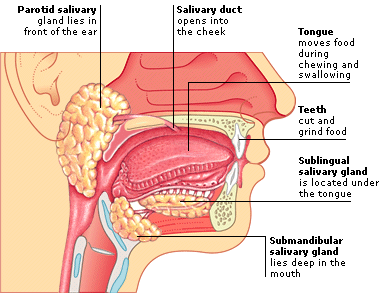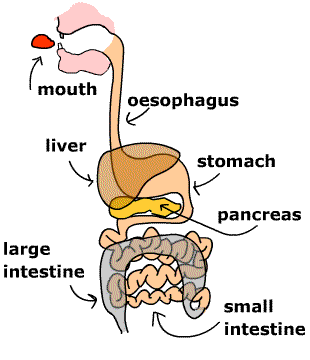
Digestive system
Ingestion
The purpose of the digestive system is to break down the food that we eat and absorb the nutirets that we get from it. There are four main processes that occur in digestion which are Ingestion, Digestion, Absorption, and Elimination. Within these processes there are organs that absorb, break down, and excrete.
The journey of Digestion begin here in the mouth also known as the Oral Cavity. When food enters the mouth it is phisically broken down by the teeth. At the same time the carbohydrates are also being chemicaly broken down by the saliva which is secreted by the Salivary Glands. The food is then turned into a bolus by the tougue. The bolus is now ready to go to the stomach, to prevent choking a flap of tissue called the epiglottis opens and closes the air way depending if you are swallowing. Now the bolus travels through the Pharynx to the Esophagus. In the Esophagus a process called Peristalsis occurs which is the rythmic contraction of muscles and pushes the bolus down to the stomach. The next process is called digestion, it begins in the stomach.
Digestion
The Stomach is the first organ included in the process of digestion. It contains a substance called Gastric Juice. This juice is a combination of Hydrochloric acid and Pepsin. It has a pH of 2 so it can dissolve most of the stuff that we eat. How is the Stamach protected from it? you may ask. The stomach has a linning of mucus which must be costantly replaced in order for it to stay protected. After the stomach there comes a series of organs that produce materials to asist the break down the food we eat. These organs consist of the Pancreas and Liver. The liver produces a substances called bile which is stored in the Gall Bladder. This Bile is used to emulsify fats and break it down into small particles. This helps with the absorbtion of nutrients. The Pancreas secretes a substanced called insulin, insulin plays a big role in the bodys matabolism. Its regulates the amount of gluecose that is used by the body and is stored in the fat. After the being broken down by the stomach and the bile the food goes into the small intestine.
Absorption
This process is in charge of the absorption of nutriets. The Small Intestine is the first organ in the process of Absorption. It is made up of three parts, the first part is the Duodenum its is the smallest part of the intestine but it is where the most chemical digestion occurs. This section is where the chyme enters the small intestine, chyme is the combination of the dissolved food, stomach acid, and various digestive enzymes.the next section is called the Jejunum, this is where most of the aborabtion occurs. The Jejunum is lined with villi and microvilla to increase the surface area which boosts absorption. Lastly there is the Ileum, the function of this to absorb the nutrients that weren't absorbed in the Jejunum.
Elimination
This process is the passage of undigested material. The Main organ in this process is the large intestine which has 6 parts. These constist of the Cecum, Assending Colon, Transverse Colon, Decending Colon, Rectum, and the Anal Canal. The Cecum was used to break down cellulose but it is no longer functional in the human body. The next part is the Assending Colon its function is to absorb water and nutriets left from the Small Intestine. Then there is the Transverse Colon, its function is to remove more water and to form feces. Finally the last part of the colon, the Decending Colon, this part absorbs the remaining water from the Tranverse Colon. The Rectum is the concluding part of the Large Intestine, this is where the feces pace through to get to the Anal Cavity . Lastly there is the Anal Canal, this is where the feces leave the body.
Digestive Track Diseases
Stomach Ulcers: These are lesions in the lining allowing stomach acid to break down the stomach. This if not treated can be deadly because if the stomach acid leakes onto the other organs it would break them down because of it high acidity
Gastroesophageal Reflux Disease (GERD) –Severe “heartburn” in laymen’s language. Weakness of the valve between the esophagus and stomach may allow stomach acid to reflux into the esophagus and irritate and inflame the lining. This results in chest pain which can mimic that of angina.




<----
YAY DIGESTION!!!